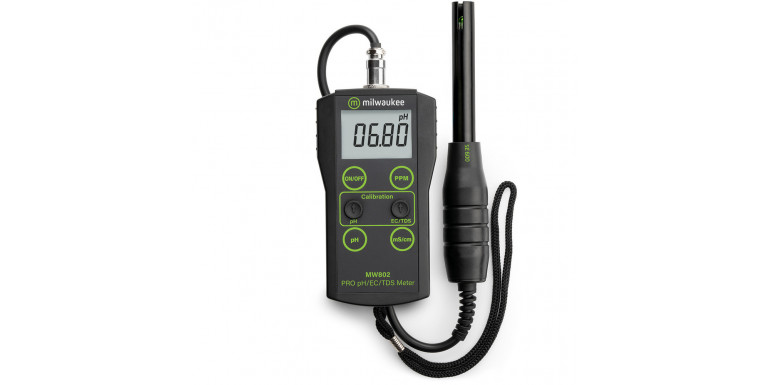
Part I: Introduction to Measuring Tools in Plant Cultivation
Chapter 1: Why Are Measurements Crucial in Advanced Plant Cultivation?
In modern plant cultivation, whether it’s traditional soil-based growing, hydroponics, or controlled environments like grow boxes, precise control of growing conditions is essential for achieving healthy plants and high yields. Monitoring key parameters such as pH, electrical conductivity (EC), and humidity is critical because each of these factors influences the plants’ ability to absorb nutrients, breathe, and thrive.
Key Parameters to Monitor
There are a few essential parameters to keep a close eye on during plant cultivation:
pH – This measures the acidity or alkalinity of the soil or nutrient solution. Even slight deviations from the optimal range can significantly impact a plant’s ability to absorb nutrients, leading to deficiencies or toxicity.
EC (Electrical Conductivity) – This measures the amount of dissolved mineral salts in the nutrient solution. Too high EC can damage roots and weaken plants, while too low EC means insufficient nutrients for growth.
Humidity – Both air and soil moisture play critical roles in plant health. Too dry an environment leads to rapid water evaporation, while excessive humidity promotes mold and disease development.
How Parameters Affect Plant Health
Failure to monitor and adjust these parameters properly can lead to significant cultivation problems. For instance, an incorrect pH level can render certain nutrients unavailable to the plant, causing deficiencies even if the soil or solution is nutrient-rich. Likewise, improper electrical conductivity can result in soil salinity, which stunts plant growth and may eventually kill the plant.
Humidity is equally important – too low a humidity level can disrupt transpiration, while too high a level fosters fungal growth. Optimizing these factors enables better control over the plant's metabolic processes and provides ideal conditions for growth.
Consequences of Poor Control
Improper values for pH, EC, or humidity can quickly weaken plants, slow growth, and reduce yields. In hydroponic systems, where plants receive nutrients directly from a solution, incorrect EC or pH levels can have immediate effects, like root burn or nutrient deficiencies. In traditional soil cultivation, the soil acts as a buffer, but prolonged deviations from optimal conditions can still cause similar issues.
This is why more growers, both professional and amateur, are turning to advanced measuring tools like those offered by Bluelab. These devices enable precise control of the plant's environment, ensuring optimal results. In the following chapters, we will discuss the essential measuring tools, how to use them, and how to maintain the right conditions for your plants.
Chapter 2: Overview of Key Cultivation Parameters
In plant cultivation, regardless of the method (traditional, hydroponic, or aeroponic), it is crucial to monitor several fundamental parameters that directly influence plant health and productivity. Measuring key factors like pH, electrical conductivity (EC), humidity, and temperature allows for real-time adjustments to meet the plant's needs. Below, we provide an in-depth explanation of the most critical parameters.
1. pH – Acidity and Alkalinity of Soil and Nutrient Solution
pH is a measure of the acidity or alkalinity of the environment in which the plant grows. pH values range from 0 (very acidic) to 14 (very alkaline), with 7 being neutral. For most cultivated plants, the optimal pH range is between 5.5 and 6.5, although some plants prefer other ranges.
The Impact of pH on Plants:
- Low pH (acidic) can cause excessive uptake of certain micronutrients like aluminum or manganese, which in large amounts can become toxic to plants.
- High pH (alkaline), on the other hand, may limit the availability of key nutrients like iron, leading to chlorosis (yellowing of leaves) and other deficiencies.
Therefore, regular pH measurement is crucial, especially in hydroponic systems where soil does not act as a buffer and all nutrients are provided in water form.
2. EC – Electrical Conductivity, or the Level of Nutrients
Electrical conductivity (EC) is an indicator of the amount of dissolved mineral salts in the nutrient solution, which are directly available to plants. The higher the EC, the more nutrients are in the water.
Importance of EC for Plants:
- Too low EC means the plants lack sufficient nutrients for growth, resulting in slower development and weaker yields.
- Too high EC can cause salt buildup in the roots, inhibiting water and nutrient uptake, leading to salt stress and root damage.
The optimal EC level depends on the plant’s growth stage—lower EC is recommended during the vegetative phase, while higher nutrient levels (and thus higher EC) are beneficial during the flowering phase.
3. Humidity – Both Soil and Air Moisture
Humidity refers to both the water content in the soil (or growing medium) and the air moisture surrounding the plant.
Soil Moisture:
- Too low soil moisture leads to water stress and plant dehydration, which manifests in wilting leaves, slow growth, and reduced nutrient uptake.
- Too high soil moisture restricts oxygen to the roots, promoting root rot and the growth of pathogens.
Air Humidity:
- Low air humidity speeds up the transpiration process (water loss through the leaves), which can lead to excessive evaporation and the need for more frequent watering.
- High air humidity promotes the growth of mold and fungi, which can damage plant health.
Humidity monitoring is especially important in enclosed growing environments, such as grow boxes, where the microclimate can differ significantly from outdoor conditions.
4. Temperature – Regulating Heat in Cultivation
Temperature is another critical factor that influences plant metabolic processes. Too low a temperature slows these processes, potentially stunting growth, while too high a temperature can cause heat stress and even damage the plants.
The optimal temperature for most cultivated plants ranges between 18°C and 25°C during the day, with slightly lower temperatures at night.
How Often Should Measurements Be Taken?
The frequency of measurements depends on the type and stage of the cultivation. In hydroponic systems, daily monitoring of pH and EC is recommended as the nutrient solution can change rapidly. In traditional soil cultivation, measurements may be taken less frequently, but should still be regular, especially during periods of rapid plant growth.
It is also crucial to monitor humidity and temperature, especially in closed environments where the microclimate can fluctuate and affect plant health.
Conclusion
Accurately controlling parameters like pH, EC, humidity, and temperature is essential for achieving optimal results in plant cultivation. Monitoring these factors enables quick adjustments to changing conditions and gives growers greater control over crop quality. In the following parts, we will discuss how to use Bluelab measurement tools to provide your plants with the ideal conditions for growth.

